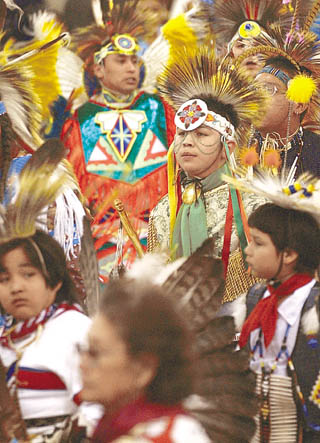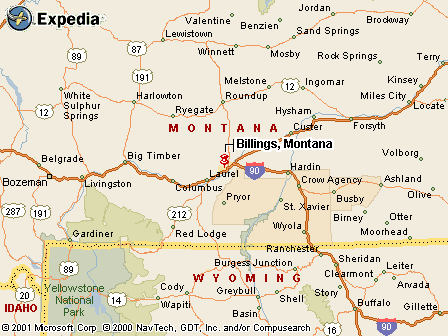|
|
Canku Ota |
|
|
(Many Paths) |
||
|
An Online Newsletter Celebrating Native America |
||
|
April 6, 2002 - Issue 58 |
||
|
|
||
|
Children are Vital to Weekend Pow Wow |
||
|
by Becky Shay Billings
Gazette Staff
|
||
|
credits:
James Woodcock/Gazette Staff
|
 Sometimes
they stumble and occasionally they refuse to dance, but the children contribute
to a powwow like no other participants. Sometimes
they stumble and occasionally they refuse to dance, but the children contribute
to a powwow like no other participants.
"They are sacred to our future," powwow announcer Burton Pretty On Top Sr. said. "They honor us with their innocence, their purity." Whether they are dancing in an intertribal, a special dance that recognizes their contribution to the gathering, or the competitive sections, children have special places at powwows. Kids made up about a quarter of the more than 100 dancers registered at the Montana State University-Billings Intertribal Indian Club Powwow. Boy Scout and Girl Scout troops danced in line with the royalty and color guards who launched the evening grand entry at the fairgrounds' Montana Pavilion Friday night. Emma Clairmont, 4, of Rosebud, S.D., was among the little girls fancy dancing. Clairmont swung her bright yellow shawl and bounced in her blue-beaded leggings while her sister, Annessa, 8, had her hair braided in preparation for traditional competition. The girls just grinned when asked why they like to dance, but their mother said following the powwow trail goes back generations in their family. Sylvester Spotted Bear, of Pryor, has three daughters who dance. He judged the junior boys competition. Children are never forced to dance, he said, but neither are they ever denied the opportunity to dance. "If you have a very traditional family, it goes without question the children are going to dance," Spotted Bear said. "For most of these children, it's natural for them to want to be out there." Some children are influenced into the various categories of dance by following their parents and other elders, he said, but others will chose a style that matches their personalities. While many will be taught to dance, most develop their own style over the years, Spotted Bear said. Families may automatically provide dancing outfits for their children, he said, but if they don't and a child asks for regalia it will be made available one way or another. Spotted Bear works with teens and had many students dancing this weekend. Powwows help them "get involved in tradition and culture and make them aware of who they are," he said. One of the best ways for children to get involved is by joining an intertribal dance. Especially at a powwow like MSU-B's, there are always intertribal dances in which anyone - regardless of regalia and heritage - is encouraged to dance. There may be kids who have no outfit, but they will go out and practice during an intertribal, Spotted Bear said. They have usually been watching the older kids and want to practice dancing. "If they just walk around and feel the atmosphere, the feeling out there, they will say 'I can do that,'" he said. "They never stop anybody from getting out there - even if they are from Afghanistan or they have the most ridiculous outfit you've ever seen - no one is ever ridiculed."
|
|
|
||
|
|
||
| Canku Ota is a free Newsletter celebrating Native America, its traditions and accomplishments . We do not provide subscriber or visitor names to anyone. Some articles presented in Canku Ota may contain copyright material. We have received appropriate permissions for republishing any articles. Material appearing here is distributed without profit or monetary gain to those who have expressed an interest. This is in accordance with Title 17 U.S.C. section 107. | ||
|
Canku Ota is a copyright © 2000, 2001, 2002 of Vicki Lockard and Paul Barry. |
||
|
|
|
|
|
The "Canku Ota - A Newsletter Celebrating Native America" web site and its design is the |
||
|
Copyright © 1999, 2000, 2001, 2002 of Paul C. Barry. |
||
|
All Rights Reserved. |
||

